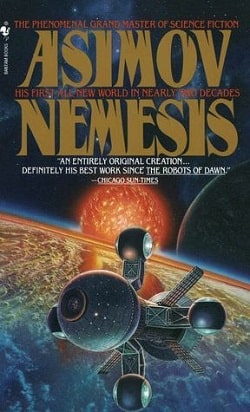Summary

Nemesis
by Isaac Asimov
In the twenty-third century pioneers have escaped the crowded earth for life in self-sustaining orbital colonies. One of the colonies, Rotor, has broken away from the solar system to create its own renegade utopia around an unknown red star two light-years from Earth: a star named Nemesis.
Now a fifteen-year-old Rotorian girl has learned of the dire threat that nemesis poses to Earth’s people—but she is prevented from warning them. Soon she will realize that Nemesis endangers Rotor as well. And so it will be up to her alone to save both Earth and Rotor as—drawn inexorably by Nemesis, the death star—they hurtle toward certain disaster.
.
Read
Nemesis on http://kissnovel.net
Martial Peak Reviews
Isaac Asimov's Nemesis is a captivating exploration of humanity's struggle for survival in the face of cosmic threats, set against the backdrop of a richly imagined future. The novel, published in 1989, transports readers to the twenty-third century, where Earth has become overcrowded, prompting pioneers to seek refuge in self-sustaining orbital colonies. Among these is Rotor, a colony that has ventured beyond the solar system to orbit a mysterious red star named Nemesis. This premise sets the stage for a gripping narrative that intertwines themes of isolation, responsibility, and the quest for knowledge.
At the heart of the story is a fifteen-year-old girl named Marlene, who embodies the spirit of curiosity and resilience. As a Rotorian, she is raised in a society that prides itself on its independence and self-sufficiency. However, her discovery of the impending threat posed by Nemesis—a star that is not just a celestial body but a harbinger of doom—forces her into a position of moral and existential conflict. Marlene's character development is profound; she transitions from a naive girl, sheltered by the ideals of her colony, to a determined young woman who recognizes the weight of her responsibility to both her home and Earth. This evolution is a central theme of the novel, highlighting the importance of individual agency in the face of overwhelming odds.
Asimov's portrayal of the relationship between Rotor and Earth is particularly compelling. The colony's detachment from Earth symbolizes a broader commentary on the consequences of isolationism. Rotor, while initially appearing as a utopian society, is revealed to have its own set of challenges and moral dilemmas. The tension between the two worlds serves as a reminder that no society is immune to the repercussions of its choices. This theme resonates with contemporary issues of environmental degradation and the ethical responsibilities of advanced civilizations, making Nemesis a thought-provoking read for modern audiences.
The narrative structure of Nemesis is engaging, with Asimov expertly weaving together multiple perspectives. The alternating viewpoints not only enrich the storytelling but also allow readers to grasp the complexities of the characters' motivations. The pacing is deliberate, building suspense as Marlene races against time to warn Earth of the impending disaster. Asimov's skillful use of foreshadowing adds layers to the plot, keeping readers on the edge of their seats as they anticipate the consequences of Marlene's actions.
One of the most striking aspects of Asimov's writing is his ability to blend scientific concepts with human emotion. The novel delves into astrophysics and the nature of stars, yet it remains accessible to readers who may not have a scientific background. Asimov's passion for science is evident, and he uses it as a vehicle to explore deeper philosophical questions about existence, fate, and the interconnectedness of life. This balance between science and humanity is a hallmark of Asimov's work, drawing parallels to other science fiction authors like Arthur C. Clarke and Philip K. Dick, who similarly grapple with the implications of technological advancement on human society.
Thematically, Nemesis raises questions about the nature of knowledge and the limits of human understanding. Marlene's journey is not just a physical one; it is also an intellectual quest as she seeks to comprehend the significance of Nemesis and its implications for her world. This quest for knowledge is juxtaposed with the dangers of ignorance, as the inhabitants of Rotor remain blissfully unaware of the true nature of their star. Asimov challenges readers to consider the consequences of willful ignorance and the importance of seeking truth, even when it is uncomfortable or frightening.
The novel's climax is both thrilling and poignant, as Marlene's efforts culminate in a race against time to avert disaster. The resolution is not merely about saving lives; it is also about the growth of a young woman who learns to embrace her role as a leader and protector. Asimov's ability to craft a satisfying conclusion while leaving room for contemplation is a testament to his mastery of the genre. The ending resonates with a sense of hope, suggesting that even in the face of overwhelming challenges, individuals can make a difference.
In conclusion, Nemesis is a remarkable work that showcases Isaac Asimov's brilliance as a science fiction author. Through the lens of a young girl's journey, the novel explores profound themes of responsibility, knowledge, and the interconnectedness of humanity. Asimov's ability to blend scientific inquiry with rich character development creates a narrative that is both intellectually stimulating and emotionally resonant. For readers seeking a thought-provoking exploration of humanity's place in the universe, Nemesis is an essential addition to the science fiction canon.
























Reviews 0
Post a Reviews: